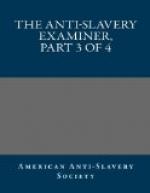Mr. SAMUEL HALL a teacher in Marietta College, Ohio, gives, in a late letter, the following statement of a fellow student, from Kentucky, of whom he says, “he is a professor of religion, and worthy of entire confidence.”
“I have seen at least fifteen droves of ‘human cattle,’ passing by us on their way to the south; and I do not recollect an exception, where there were not more or less of them chained together.”
Mr. GEORGE P.C. HUSSEY, of Fayetteville, Franklin county, Pennsylvania, writes thus:
“I was born and raised in Hagerstown, Washington county, Maryland, where slavery is perhaps milder than in any other part of the slave states; and yet I have seen hundreds of colored men and women chained together, two by two, and driven to the south. I have seen slaves tied up and lashed till the blood ran down to their heels.”
Mr. GIDDINGS, member of Congress from Ohio, in his speech in the House of Representatives, Feb. 13, 1839, made the following statement:
“On the beautiful avenue in front of the Capitol, members of Congress, during this session, have been compelled to turn aside from their path, to permit a coffle of slaves, males and females, chained to each other by their necks, to pass on their way to this national slave market.”
Testimony of JAMES K. PAULDING, Esq. the present Secretary of the United States’ Navy.
In 1817, Mr. Paulding published a work, entitled ’Letters from the South, written during an excursion in the summer of 1816.’ In the first volume of that work, page 128, Mr. P. gives the following description:
“The sun was shining out very hot—and in turning the angle of the road, we encountered the following group: first, a little cart drawn by one horse, in which five or six half naked black children were tumbled like pigs together. The cart had no covering, and they seemed to have been broiled to sleep. Behind the cart marched three black women, with head, neck and breasts uncovered, and without shoes or stockings: next came three men, bare-headed, and chained together with an ox-chain. Last of all, came a white man on horse back, carrying his pistols in his belt, and who, as we passed him, had the impudence to look us in the face without blushing. At a house where we stopped a little further on, we learned that he had bought these miserable beings in Maryland, and was marching them in this manner to one of the more southern states. Shame on the State of Maryland! and I say, shame on the State of Virginia! and every state through which this wretched cavalcade was permitted to pass! I do say, that when they (the slaveholders) permit such flagrant and indecent outrages upon humanity as that I have described; when they sanction a villain in thus marching half naked women and men, loaded with chains, without being charged with any crime but that of being black from one section of the United States to another, hundreds of miles in the face of day, they disgrace themselves, and the country to which they belong."[10]




